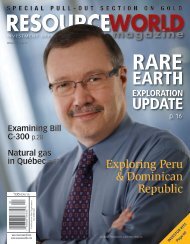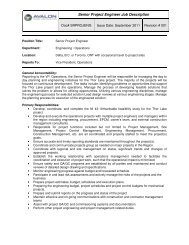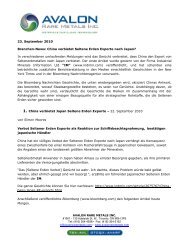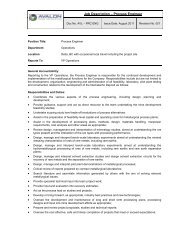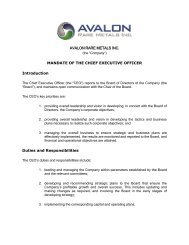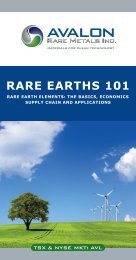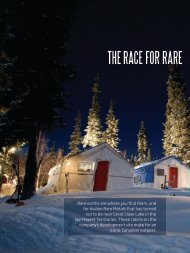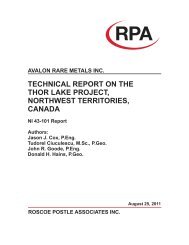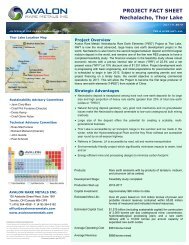technical report on the nechalacho deposit, thor lake project ...
technical report on the nechalacho deposit, thor lake project ...
technical report on the nechalacho deposit, thor lake project ...
Create successful ePaper yourself
Turn your PDF publications into a flip-book with our unique Google optimized e-Paper software.
14. DATA VERIFICATION<br />
QUALITY ASSURANCE / QUALITY CONTROL<br />
In 2007, Aval<strong>on</strong> commissi<strong>on</strong>ed CDN Laboratory from British Columbia to generate three<br />
standards called AVL-H, AVL-M or AVL-L. These standards would be inserted into <strong>the</strong> assay<br />
stream. Aval<strong>on</strong> <strong>the</strong>n commissi<strong>on</strong>ed Dr. Barry Smee to review <strong>the</strong> round robin and assess <strong>the</strong><br />
quality of <strong>the</strong> data.<br />
In 2010, Aval<strong>on</strong> commissi<strong>on</strong>ed CDN Laboratory from British Columbia to generate a fur<strong>the</strong>r<br />
standard called S-04-09. This standard would be inserted into <strong>the</strong> assay stream, alternating<br />
with <strong>the</strong> original three standards. Aval<strong>on</strong> <strong>the</strong>n commissi<strong>on</strong>ed Dr. Barry Smee to review <strong>the</strong><br />
round robin and assess <strong>the</strong> quality of <strong>the</strong> data. The Round Robin <strong>on</strong> <strong>the</strong> new standard included<br />
samples of <strong>the</strong> original three standards, rare earth certified standards, all randomized for <strong>the</strong><br />
Round Robin. When inserted into <strong>the</strong> sample database, this standard was referred to as STD-<br />
H2.<br />
The statistics of QAQC c<strong>on</strong>trol samples was presented previously in <strong>the</strong> Scott Wils<strong>on</strong> RPA<br />
(2010) and is updated here. The c<strong>on</strong>trol samples inserted into <strong>the</strong> sample stream from drill<br />
holes 137 to 311 are presented in Table 14-1.<br />
Table 14-1 Statistics of QAQC C<strong>on</strong>trol Samples, L09-137 to L10-311<br />
Samples Analyses Blanks Standard-L Standard-M Standard-H Standard-H2 Standards total<br />
Total number 10,491 15,474 417 180 162 121 306 769<br />
Percent of samples 4.0% 1.7% 1.5% 1.2% 2.9% 7.3%<br />
Percent of analyses 2.7% 1.2% 1.0% 0.8% 2.0% 5.0%<br />
As can be seen, blanks were inserted <strong>on</strong> average at <strong>the</strong> rate of 4.0%, or <strong>on</strong>e in 25 samples, and<br />
standards at <strong>the</strong> rate of 7.3%, or <strong>on</strong>e in 13 samples. The rate of inserti<strong>on</strong> of standards was<br />
varied according to whe<strong>the</strong>r <strong>the</strong> samples were from a mineralized z<strong>on</strong>e or not with a standard<br />
every 10 samples in mineralizati<strong>on</strong> and every 40 samples outside mineralizati<strong>on</strong>. Some 10,491<br />
samples were analysed by ALS method MS81 (so called “regular” analysis) and some 4,983, or<br />
47%, were re-analysed for method MS81H, for higher rare earth and Zr analytical limits. As<br />
noted elsewhere, samples were also analysed for additi<strong>on</strong>al methods such as tests of XRF<br />
analysis for Zr, Nb and Ta. These additi<strong>on</strong>al analyses are not included in <strong>the</strong> statistics above.<br />
The results of <strong>the</strong> standard analyses were checked against <strong>the</strong> certified or provisi<strong>on</strong>al means<br />
and tolerances listed in <strong>the</strong> standard certificates as well as against <strong>the</strong> lab’s (ALS) own precisi<strong>on</strong><br />
tolerance level of +/-10%. The three rare earth elements with <strong>the</strong> potential highest value (Nd,<br />
Technical Report 43-101 – March 13, 2011 Page 14-1<br />
Prepared by Aval<strong>on</strong> Rare Metals Inc.





